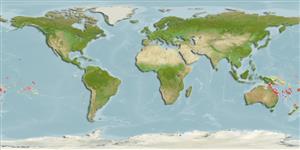>
Blenniiformes (Blennies) >
Tripterygiidae (Triplefin blennies) > Tripterygiinae
Etymology: Enneapterygius: Greek, ennea = nine times + Greek, pterygion = little fin (Ref. 45335).
More on author: Waite.
Environment: milieu / climate zone / depth range / distribution range
Ecologie
marien rifbewoner; standvastig; diepte 0 - 6 m (Ref. 13227). Subtropical
Southwest Pacific: Australia, New Caledonia (including the Loyalty Islands), Fiji, and Tonga. Records of this species from the Kermadec Islands (Ref. 8879) are based on Enneapterygius kermadecensis.
Grootte / Gewicht / Leeftijd
Maturity: Lm ? range ? - ? cm
Max length : 4.5 cm SL mannelijk / geslacht onbekend; (Ref. 54980)
Dorsale stekels (totaal): 13 - 17; Dorsale zachte stralen (totaal): 8-12; Anale stekels 1; Anale zachte stralen: 16 - 21. Small supraorbital tentacle; first dorsal fin in females shorter by 50% than second dorsal fin; in males, shorter by 25%; body translucent gray in both sexes, edges of scales varying from pink to dark reddish brown, the pink-edged scales forming blotches along back; caudal fin base bearing a white bar; top of head red; female head brown and cheek with small white spots, red lower and posterior upper lip; lower part of male head black with exception of lower lip to end of maxilla being bright red and upper part of opercle red. Dorsal rays III + X-XIV + 8-12; lateral line interrupted, 15-20 + 15-21; mandibular pores 4 + 1 + 4 (Ref. 54980).
Adults are found in shallow water and tidal pools (Ref. 13227). They feed on gastropods (Ref. 94105). Eggs are hemispherical and covered with numerous sticky threads that anchor them in the algae on the nesting sites (Ref. 240). Larvae are planktonic which occur primarily in shallow, nearshore waters (Ref. 94114).
Levenscyclus en paargedrag
Maturiteit | Voortplanting | Paaien | Eieren | Fecunditeit | Larven
Fricke, R., 1994. Tripterygiid fishes of Australia, New Zealand and the southwest Pacific Ocean (Teleostei). Theses Zool. 24:1-585. (Ref. 13227)
Status op de Rode Lijst van het IUCN (Ref. 130435)
Gevaar voor de mens
Harmless
Gebruik door de mens
Visserij: van geen belang
Meer informatie
Lokale namenSynoniemenMetabolismePredatorenEcotoxicologieVoortplantingMaturiteitPaaienPaaiaggregatiesFecunditeitEierenOntwikkeling van de eieren
ReferentiesAquacultuurAquacultuurprofielKweeklijnenGeneticaElectrophoresesErfelijkheidZiektesVerwerkingNutrientsMassaconversie
Tools
Speciale rapporten
Download XML
Internetbronnen
Estimates based on models
Preferred temperature (Ref.
123201): 21.5 - 28.1, mean 26.4 °C (based on 412 cells).
Fylogenetische diversiteitsindex (Ref.
82804): PD
50 = 0.5000 [Uniqueness, from 0.5 = low to 2.0 = high].
Bayesian length-weight: a=0.00562 (0.00258 - 0.01228), b=3.08 (2.89 - 3.27), in cm total length, based on LWR estimates for this (Sub)family-body shape (Ref.
93245).
Trofisch niveau (Ref.
69278): 3.2 ±0.3 se; based on size and trophs of closest relatives
Weerstandsvermogen (Ref.
120179): Hoog, minimale populatieverdubbelingstijd minder dan 15 maanden (Preliminary K or Fecundity.).
Fishing Vulnerability (Ref.
59153): Low vulnerability (10 of 100).
Nutrients (Ref.
124155): Calcium = 270 [97, 807] mg/100g; Iron = 1.85 [0.71, 4.20] mg/100g; Protein = 19.1 [17.5, 20.7] %; Omega3 = 0.141 [0.043, 0.456] g/100g; Selenium = 17.5 [4.2, 61.6] μg/100g; VitaminA = 35.7 [5.9, 237.9] μg/100g; Zinc = 2.8 [1.3, 5.2] mg/100g (wet weight);
